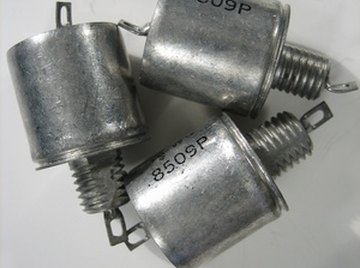
Diodes are electrical components made from semiconducting materials, such as silicon. Semiconductors are materials that will conduct electricity in some instances, but in others will not. Glass diodes are usually small signal, which means that they can handle only low currents. They are encased in hermetically sealed packages that are air-tight in order to keep gases out. One disadvantage is that they are fragile and may fail to work if the casing is cracked or if there is too much heat. To identify a glass diode, observe its coloration and label, and then input its part number into a database.
- 1N4148 diode
- 1N914 diode
- 1N4743A diode
Examine the diode carefully and note the color of the casing and the band. The band color is usually black, though some are white or red. The function of the band is to indicate the diode’s cathode or negative terminal. The casing is normally colored, though a few are clear.
Observe the lettering on the diode’s case. Do this by rotating the diode. To conserve space, the first few letters are not always written on the same side as the others, and so the total must be combined. For example, an orange diode with a black stripe and the lettering “1N4” and “148” means that the component is a 1N4148.
Find a manufacturer’s or supplier’s website, such as Fairchild Semiconductor, ON Semiconductor, NXP Semiconductors or NTE Electronics. Sites such as these keep searchable databases for customers to find information about parts. The databases will give details on a diode's appearance, specifications and usage. They will also normally include data sheets.
Practice inputting 1N4148 into any of the databases. The 1N4148 is identified as a high-speed switching diode that is made from silicon. Some websites will describe all of its variations, so be careful to choose the one that is in the correct package. For example, Fairchild Semiconductor will list the 1N4148 in a DO-35 package that is cylindrical and made of glass.
Practice searching for specifications on 1N914 and 1N4743A. The 1N914 is a high-speed switching diode that is similar to the 1N4148. The 1N4743A is a zener diode that can provide a reference voltage of 13 volts and is heat resistant.
Things You'll Need
References
- The Electronics Club: Diodes
- “Practical Electronics For Inventors 2/E”; Paul Scherz; 2006
About the Author
Kim Lewis is a professional programmer and web developer. She has been a technical writer for more than 10 years and has written articles for businesses and the federal government. Lewis holds a Bachelor of Science, and occasionally teaches classes on how to program for the Internet.
Photo Credits
diodes image by Albert Lozano from Fotolia.com
